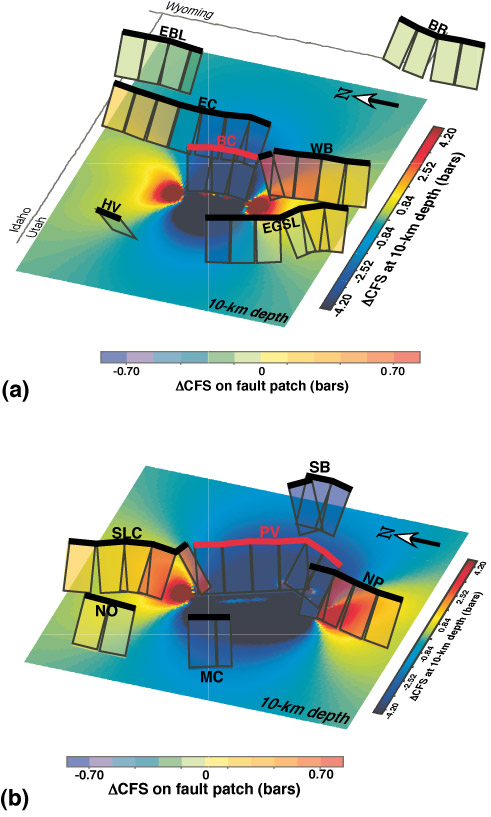
Yellowstone Plume, Hotspot, Teton Fault, and Wasatch Front Earthquake Research

|
|
Published in Journal of Geophysical Research in November 2006
GPS measurements from temporary and permanent stations were analyzed to obtain strain accumulations on the Wasatch fault. For a 65-km wide area centered on the fault, the principal horizontal extension rate is 24 ± 6 nstrain/yr in a direction perpendicular to the fault, corresponding to an extension rate of 1.6 ± 0.4 mm/yr, or about 50% of the crustal deformation across the 200-km wide eastern Basin-Range. Finite strain models of simple shear deformation of the fault hanging wall were constructed and used to convert vertical fault throw to horizontal displacement. The models revealed that horizontal deformation rates derived from paleoseismic studies would match rates from GPS if the Wasatch fault had a dip greater than 30°.
More Information:
|

|
||||||||||||||||||||||||||||||||||||||||||||||||||||||||||||||||||||||||||||||||||||||||||||||||||||||||||||||||||||||||||||||||||||||||||||||||||||||
Published in Bulletin of the Seismological Society of America in June 2002
Several factors affecting earthquake hazard estimates on the Wasatch Front were evaluated: fault-stress contagion, space-time distribution of paleaoearthquakes, contemporary deformation rates from GPS, and historic seismicity. Static stress changes from large earthquakes were modeled for the scenario earthquakes on the Wasatch fault and found that stresses increased on fault planes located along the projection of the strike of the originally rupturing plane but decreased in regions perpendicular to the fault rupture. The ages and displacements of prehistoric earthquakes on the Wasatch fault were found to be consistent with either 17 single-segment ruptures or 11 multi-segment ruptures. Multi-segment Wasatch earthquakes were considered more plausible, as other large, historic, normal faulting earthquakes of the Basin-Range tended to involve multiple segments. GPS strain rates at the Wasatch Front were found to exceed strain rates calculated from paleoseismic fault slip rates by a factor of 10, indicating that the geodetically measured deformation must be either partially aseismic or that the Wasatch Front is currently being loaded at unusually high rates. Frequency of occurrence of large earthquakes was estimated using a modified Gutenberg-Richter relation with historical seismicity and fault-slip rates from paleoearthquakes, and it was found that occurrence rates from fault-slip rates exceeded occurrence rates from historical seismicity by a factor of about three. It is hypothesized that the Wasatch Fault follows a characteristic earthquake model, in which seismic energy release on a fault is released through earthquakes of a given size rather than a distribution of magnitudes.
More Information:
|

|

|
||||||||||||||||||||||||||||||||||||||||||||||||||||||||||||||||||||||||||||||||||||||||||||||||||||||||||||||||||||||||||||||||||||||||||||||||||||||